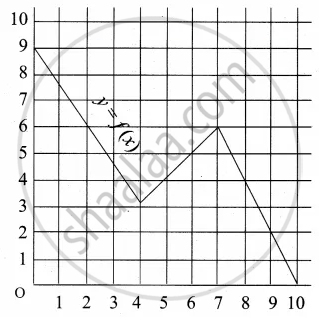Advertisements
Advertisements
प्रश्न
If `log((x + y)/3) = 1/2 log x + 1/2 logy`, show that `x/y + y/x` = 7
उत्तर
`log((x + y)/3) = 1/2 log x + 1/2 logy`
∴ `log((x + y)/3) = 1/2 (log x + logy)`
∴ `log((x + y)/3) = 1/2 log xy`
∴ `log((x + y)/3) = log(xy)^(1/2)`
∴ `(x + y)/3 = (xy)^(1/2)`
Squaring both sides, we get,
`((x + y)/3)^2` = xy
∴ `(x + y)^2/9` = xy
∴ x2 + 2xy + y2 = 9xy
∴ x2 + y2 = 7xy
Dividing both sides by xy, we get,
`(x^2)/(xy) + (y^2)/(xy) = (7xy)/(xy)`
∴ `x/y + y/x` = 7
APPEARS IN
संबंधित प्रश्न
Define a function as a correspondence between two sets.
find: f(1), f(−1), f(0) and f(2).
Let f : R+ → R, where R+ is the set of all positive real numbers, such that f(x) = loge x. Determine
(b) {x : f(x) = −2}
Write the range of the function f(x) = cos [x], where \[\frac{- \pi}{2} < x < \frac{\pi}{2}\] .
If\[f\left( x \right) = 1 - \frac{1}{x}\] , then write the value of \[f\left( f\left( \frac{1}{x} \right) \right)\]
Write the domain and range of function f(x) given by \[f\left( x \right) = \sqrt{\left[ x \right] - x}\] .
Let A and B be two sets such that n(A) = p and n(B) = q, write the number of functions from A to B.
If f(x) = cos (log x), then value of \[f\left( x \right) f\left( 4 \right) - \frac{1}{2} \left\{ f\left( \frac{x}{4} \right) + f\left( 4x \right) \right\}\] is
If \[e^{f\left( x \right)} = \frac{10 + x}{10 - x}\] , x ∈ (−10, 10) and \[f\left( x \right) = kf\left( \frac{200 x}{100 + x^2} \right)\] , then k =
The domain of definition of \[f\left( x \right) = \sqrt{4x - x^2}\] is
Check if the following relation is function:

If f(m) = m2 − 3m + 1, find f(−3)
If f(x) = `{(x^2 + 3"," x ≤ 2),(5x + 7"," x > 2):},` then find f(3)
If f(x) = `{(x^2 + 3"," x ≤ 2),(5x + 7"," x > 2):},` then find f(0)
Find x, if g(x) = 0 where g(x) = `(18 -2x^2)/7`
Find the domain and range of the following function.
f(x) = `sqrt((x - 3)/(7 - x))`
Express the area A of circle as a function of its diameter d
Let f be a subset of Z × Z defined by f = {(ab, a + b) : a, b ∈ Z}. Is f a function from Z to Z? Justify?
Check the injectivity and surjectivity of the following function.
f : Z → Z given by f(x) = x2
Prove that alogcb = blogca
Solve for x.
2 log10 x = `1 + log_10 (x + 11/10)`
Answer the following:
Find whether the following function is one-one
f : R − {3} → R defined by f(x) = `(5x + 7)/(x - 3)` for x ∈ R − {3}
Answer the following:
Find x, if x = 33log32
Answer the following:
If `log (("a" + "b")/2) = 1/2(log"a" + log"b")`, then show that a = b
Answer the following:
Solve : `sqrt(log_2 x^4) + 4log_4 sqrt(2/x)` = 2
Answer the following:
If `log"a"/(x + y - 2z) = log"b"/(y + z - 2x) = log"c"/(z + x - 2y)`, show that abc = 1
Given the function f: x → x2 – 5x + 6, evaluate f(x – 1)
A graph representing the function f(x) is given in it is clear that f(9) = 2

What is the image of 6 under f?
A function f is defined by f(x) = 2x – 3 find `("f"(0) + "f"(1))/2`
The data in the adjacent table depicts the length of a person's forehand and their corresponding height. Based on this data, a student finds a relationship between the height (y) and the forehand length (x) as y = ax + b, where a, b are constant.
| Length ‘x’ of forehand (in cm) |
Height 'y' (in inches) |
| 35 | 56 |
| 45 | 65 |
| 50 | 69.5 |
| 55 | 74 |
Check if this relation is a function
The data in the adjacent table depicts the length of a person's forehand and their corresponding height. Based on this data, a student finds a relationship between the height (y) and the forehand length (x) as y = ax + b, where a, b are constant.
| Length ‘x’ of forehand (in cm) |
Height 'y' (in inches) |
| 35 | 56 |
| 45 | 65 |
| 50 | 69.5 |
| 55 | 74 |
Find the height of a person whose forehand length is 40 cm
If f(x) = `(x - 1)/(x + 1), x ≠ - 1` Show that f(f(x)) = `- 1/x`, Provided x ≠ 0
If f(x) = `{{:(x^2",", x ≥ 0),(x^3",", x < 0):}`, then f(x) is ______.
Find the domain of the following function.
f(x) = [x] + x
Find the domain of the function f given by f(x) = `1/sqrt([x]^2 - [x] - 6)`
Let A and B be any two sets such that n(B) = p, n(A) = q then the total number of functions f : A → B is equal to ______.
The domain and range of real function f defined by f(x) = `sqrt(x - 1)` is given by ______.
Which of the following functions is NOT one-one?
Range of the function f(x) = `x/(1 + x^2)` is ______.
